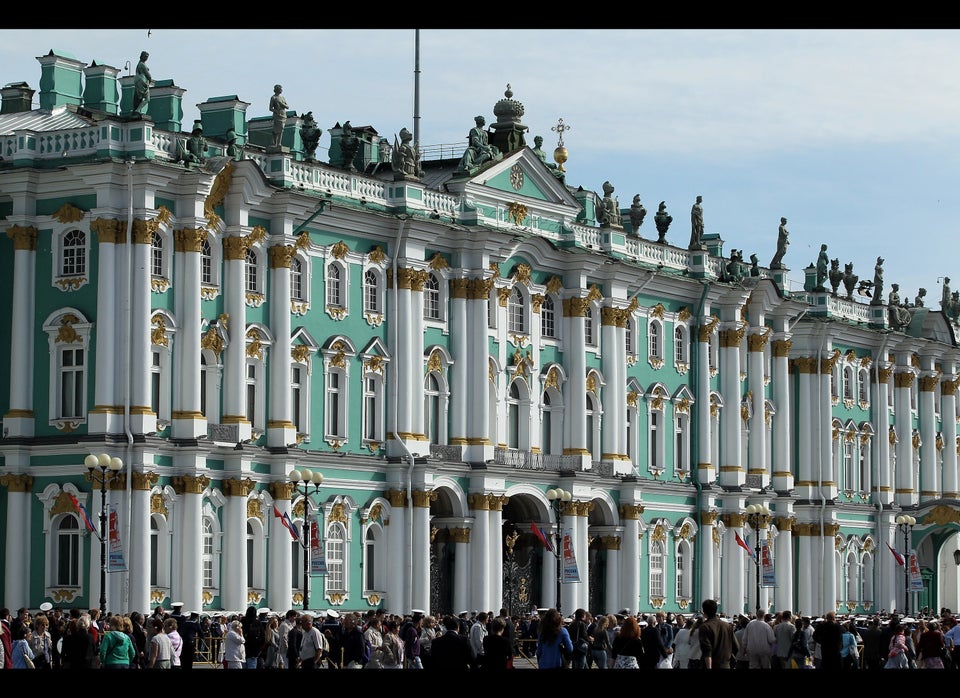This past summer I traveled to two major Northern Hemisphere cites cherished for their museums' vast art collections, yet as a warm-weather visitor, I must admit, I was most memorably charmed by touring their scenic canals and riverside locations. The first visit was to St. Petersburg, Russia, a new spot for me, while the second visit was to Amsterdam, a city I know well and once called home, not too long ago.
St. Petersburg was a marvel, delivering upon every guide-book expectation, particularly The Hermitage, whose collection's diversity and enormity still boggles my mind. With candy-colored, Baroque-style palaces built in homage to beautiful Russian princesses and ballet performances held in theaters where the dull pallor of communism seemed never to have entered, St. Petersburg continues to enlighten its visitor just as its founder, Peter the Great, had intended.
Staying at the brand new W Hotel St. Petersburg, I found the city's aesthetic priority extended. Decorated with hints of the brand's signature purple, though subtly infused alongside Italian designer Antionio Citterio's (of B&B Italia fame) contemporary, clean-lined furnishings, the W's sexy image and leisure-aimed message seems ideal for today's St. Petersburg.
Although St. Petersburg will never (and wouldn't dare) compete with rival, Moscow, and its flashy image, the city is poised to offer its citizens, and particularly its tremendous influx of visitors, its own brand of luxury lifestyle. After all, St. Petersburg is known as "Venice of the North" and renowned for its annual, "White Nights" phenomenon, where darkness is kept at bay until 4 a.m., if even at all, challenging all late-night revelers to test their endurance.
I was there during White Nights, which runs approximately from late May through early July, and I can attest to the time's rampant reverie, consistent throughout the city, however nowhere so concentrated as by the river. The phenomenon's must-do activity (equally for a regular city visit as well) is to hop aboard a boat and cruise along the city's main vein, the River Neva, to witness the daily opening of the bridges at around 1 a.m., which allows for taller boat traffic to enter and depart — and effectively cuts off connection between the city's two sides for at least a few hours. (Tourists depending on car transport between either side late at night, beware!) I'll never forget the multitudes of boats crowding the river, the throbbing house music carrying across the river's chop and the spectacular sight of the Hermitage, the Fortress and the various riverfront palaces lit up at night.
Not surprisingly, the energy and its setting reminded me of another festival, in another city of canals. Equally as crowded and exuberantly celebrated is Amsterdam's annual Queen's Day. Each year, on April 30, the city of Amsterdam (and all of The Netherlands) celebrates the Queen's birthday by dressing in head-to-toe orange and generally making a spectacle of themselves throughout the streets and upon the canals. However, every other day of the year — weather permitting — the canals of Amsterdam offer a calm and pleasant vantage point from which to enjoy intimate views and distinct perspective on the historic city. In fact, it was Amsterdam's canals that inspired Peter the Great to introduce them in St. Petersburg.
My latest visit, just a week ago, featured abnormally warm weather, particularly after a summer of rain and cold. From Friday through Sunday morning, the sun glittered off the Amstel River and its multiple canals, encouraging its citizens to hop aboard any vessel they could find. (The Dutch can be remarkably industrious when it comes to appreciating the good weather.) Whether it was families picnicking, overflowing tour-boats crowding as they took turns passing under the various bridges or student-filled boats playing music and toasting the good weather, the canals were alive, teeming with boat traffic.
Fortunately, this past stay, I was lodging at the iconic and Amstel River-fronting, De L'Europe hotel, which has just undergone a €61 million renovation bringing modern amenities, materials and jewel tones to the traditional 19th-century architecture. The brand new Dutch Masters Wing is of particular note due to its ample dimensions, unfamiliar in Amsterdam's city center. Moreover, the wing's 42 Master Suites feature oversize reproductions of the work of famous Dutch Masters and modern amenities such as motion-lit footpaths, bathrooms with TV-embedded mirrors and heated floors and in-room directories housed on iPads. While only a few suites come with terraces overlooking the River, similar waterside views can be found while dining at the hotel's tempting terrace restaurant — try the steak tartare — or from the ground-level gym, whose windows put exercisers at eye-level with passing boat traffic.
Despite these two northern cities prowess in both antique fine art and emerging, contemporary ingenues (check out Marina Gisich's gallery in St. Petersburg or Amsterdam's beloved design store, the Frozen Fountain), their true charm lies in their flowing underbelly, elegantly preserved, heavily appreciated and deliciously accessible to all.
